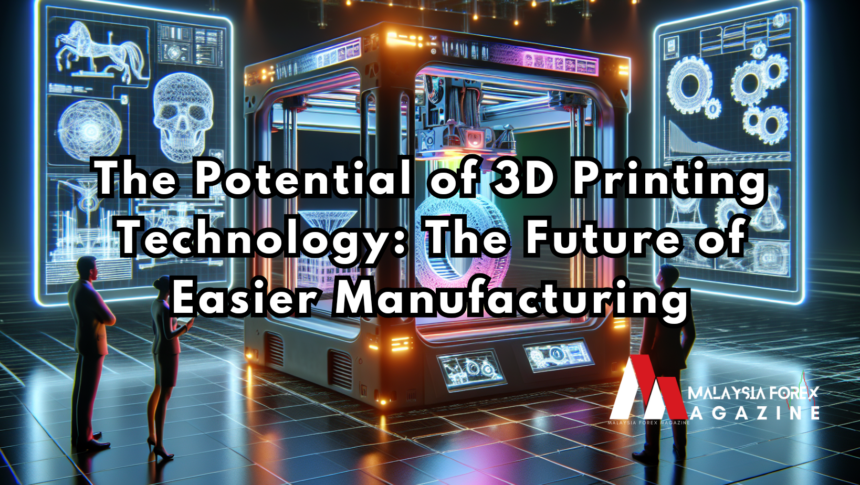3D printing technology, also known as additive manufacturing, has rapidly evolved from a niche innovation to a mainstream technology with widespread applications. From industrial manufacturing to healthcare, education, and even art, 3D printing is transforming the way we create and produce objects. This article will explore the potential of 3D printing technology, its advantages, current applications, and how it’s shaping the future of manufacturing to be faster, more flexible, and highly efficient.
1. What is 3D Printing and How Does It Work?
3D printing is a process of creating a three-dimensional object by building it layer by layer from a digital model. The technology works by using materials such as plastic, metal, resin, or even biological cells, and printing them in successive layers until a fully-formed object emerges. The process typically involves three main steps:
- Designing the Model: First, a digital model is created using Computer-Aided Design (CAD) software or obtained from a 3D scanning device.
- Slicing: The digital model is divided into thin layers, a process known as “slicing,” which tells the printer how to build each layer of the object.
- Printing: The 3D printer reads the sliced file and builds the object layer by layer, following the digital blueprint.
3D printing technology has evolved from simple plastic models to using a variety of complex materials, enabling diverse applications across multiple sectors.
2. Advantages of 3D Printing in Manufacturing
The rise of 3D printing has introduced many advantages that make it highly attractive in the manufacturing industry:
- Cost-Efficiency: 3D printing reduces the need for expensive molds and tooling required in traditional manufacturing. This allows companies to produce small quantities or prototypes at a fraction of the cost.
- Speed and Flexibility: Manufacturers can produce parts quickly and make rapid adjustments to designs. This flexibility enables faster product development cycles and reduces lead times.
- Customization: 3D printing makes it easy to customize products based on individual specifications. From personalized medical devices to tailored automotive parts, customization is one of the most promising benefits.
- Less Waste: Traditional manufacturing methods often waste materials, but 3D printing builds only the necessary layers. This makes it a sustainable option with lower material wastage and environmental impact.
- Complex Designs: 3D printing enables the creation of intricate designs that would be difficult or impossible to achieve with conventional methods. It allows for complex geometries, such as hollow parts and internal structures.
3. Applications of 3D Printing Across Industries
3D printing has a wide range of applications that are redefining multiple industries:
- Healthcare: In healthcare, 3D printing is used to create customized prosthetics, implants, and even medical devices tailored to each patient’s unique anatomy. Bioprinting, a branch of 3D printing, is making strides towards printing human tissues and organs for medical research and potential future transplants.
- Automotive and Aerospace: Companies in the automotive and aerospace industries use 3D printing to produce lightweight and durable parts. This technology enables faster prototyping, which helps accelerate innovation in vehicle and aircraft design.
- Construction: Large-scale 3D printing is starting to impact construction, enabling the rapid creation of building components and even entire houses. This method can significantly reduce construction costs and project timelines.
- Consumer Goods: From shoes and accessories to furniture and home decor, 3D printing is making customized consumer goods accessible. Customers can design their products online and have them printed to order.
- Education and Research: Schools and universities are using 3D printers to introduce students to manufacturing and engineering concepts. It’s a valuable tool for hands-on learning and experimentation.
4. The Future Potential of 3D Printing in Manufacturing
The future of 3D printing holds transformative potential, with significant advancements on the horizon:
- Large-Scale 3D Printing: As 3D printers become larger and more powerful, it may be possible to print entire buildings, bridges, and even infrastructure. This could revolutionize construction and address housing shortages in a sustainable way.
- Bioprinting for Healthcare: Bioprinting is developing quickly and could allow scientists to print functional organs like kidneys or livers. While we’re still in the early stages, this advancement could alleviate organ shortages in the future.
- Multi-Material Printing: Currently, 3D printers are limited to one material at a time in most cases. In the future, multi-material 3D printing could enable the simultaneous use of different materials, allowing for even more complex and functional designs.
- Distributed Manufacturing: 3D printing can enable manufacturing to occur closer to the consumer, reducing transportation costs and emissions. In the future, companies could operate on a distributed manufacturing model, where products are printed on-demand at local facilities.
- Integration with Artificial Intelligence (AI): AI is expected to enhance 3D printing processes by optimizing designs, detecting errors, and improving efficiency. Machine learning algorithms can predict potential design flaws and suggest improvements, enhancing quality and precision.
5. Challenges and Considerations
While the future of 3D printing is promising, there are challenges that need to be addressed:
- Material Limitations: The range of materials that can be used in 3D printing is still limited compared to traditional manufacturing. However, ongoing research is working to expand material options.
- High Initial Costs: Although 3D printing can save costs over time, the initial cost of industrial-grade 3D printers can be high. This might be a barrier for small businesses or individual creators.
- Quality and Durability: Ensuring that 3D printed products meet the quality standards and durability required for industrial use is essential. Further developments are needed to enhance the structural integrity of printed objects.
- Intellectual Property (IP) Concerns: The ease of replicating products with 3D printing brings IP concerns, as designs can be easily shared and reproduced. Companies will need to find solutions to protect their IP in a 3D-printed world.
6. Conclusion: A Revolutionary Step Towards the Future
3D printing technology has the potential to revolutionize manufacturing by making production faster, more sustainable, and customizable. From small businesses to large industrial players, the benefits of 3D printing are becoming more apparent. As technology advances, it will bring new opportunities for creativity, efficiency, and accessibility in the manufacturing sector.
In the future, 3D printing could become a standard part of manufacturing processes, with applications extending beyond our current understanding. Embracing this technology and overcoming its challenges will pave the way for a new era of efficient and versatile manufacturing. Whether it’s in creating custom medical devices, building infrastructure, or producing unique consumer goods, 3D printing is set to shape a future where making things is easier, faster, and more innovative than ever before.











